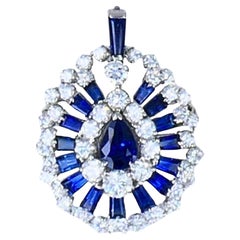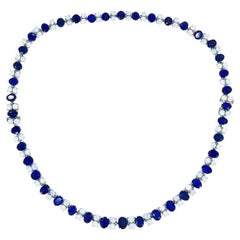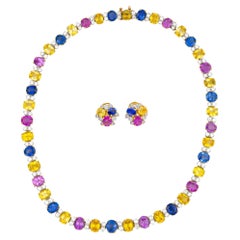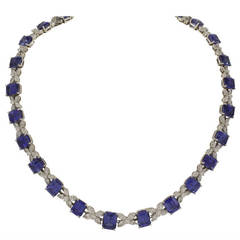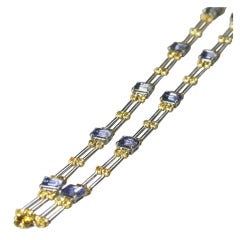Oscar Heyman Sapphire Necklace
Vintage 1960s American Necklace Enhancers
Diamond, Sapphire, Platinum
Vintage 1960s American More Necklaces
Diamond, Sapphire, Platinum
20th Century American Modern Chain Necklaces
Diamond, Sapphire, 18k Gold
Vintage 1960s American More Necklaces
Diamond, Sapphire, Platinum
21st Century and Contemporary American Modern Pendant Necklaces
Diamond, Sapphire, White Gold
Recent Sales
1990s American Choker Necklaces
Diamond, Sapphire, Platinum
20th Century American Modern Multi-Strand Necklaces
Diamond, Sapphire, Platinum, 18k Gold
21st Century and Contemporary American Modern Chain Necklaces
Sapphire, Blue Sapphire, Diamond, Platinum
21st Century and Contemporary American Modern Choker Necklaces
Pink Sapphire, Diamond, White Diamond, Sapphire, Platinum
20th Century American Modern More Necklaces
Sapphire, Blue Sapphire, Pink Sapphire, Yellow Sapphire, Green Sapphire,...
21st Century and Contemporary American Modern Drop Necklaces
Diamond, White Diamond, Emerald, Ruby, Sapphire, 18k Gold, Yellow Gold
21st Century and Contemporary American Modern Pendant Necklaces
White Diamond, Star Sapphire, Platinum
Late 20th Century American More Necklaces
Diamond, Sapphire, 18k Gold, Platinum
20th Century American Choker Necklaces
Diamond, White Diamond, Sapphire, Blue Sapphire, Pink Sapphire, Yellow S...
20th Century American Drop Necklaces
Diamond, Sapphire, Platinum
Late 20th Century American Link Necklaces
Diamond, White Diamond, Sapphire, Blue Sapphire, 18k Gold, Yellow Gold
Vintage 1960s American Necklace Enhancers
Diamond, Ruby, Sapphire, Platinum
People Also Browsed
2010s Aesthetic Movement Bangles
White Diamond, Yellow Diamond, Black Diamond, Rubelite, 18k Gold, Palladium
Early 2000s Link Necklaces
18k Gold, Yellow Gold
Vintage 1970s Italian Modern Clip-on Earrings
18k Gold
Late 20th Century French Retro Clip-on Earrings
Ruby, 18k Gold, Yellow Gold
Vintage 1950s American Beaded Bracelets
18k Gold
1990s Italian Skirt Suits
1970s French Coats
Antique Mid-19th Century French Victorian Drop Necklaces
Diamond, Pearl, Ruby, Gold
1990s British Suits, Outfits and Ensembles
Early 2000s Evening Gowns
1960s Cropped Jackets
1980s French Evening Dresses and Gowns
1990s French Skirt Suits
21st Century and Contemporary Cuff Bracelets
2010s French Duffel Bags and Carry-On Bags
1980s French Evening Gowns
Oscar Heyman Sapphire Necklace For Sale on 1stDibs
How Much is a Oscar Heyman Sapphire Necklace?
Oscar Heyman for sale on 1stDibs
Known as “the jewelers’ jeweler,” Oscar Heyman (1888–1970) designed pieces for Cartier, Tiffany & Co., Van Cleef & Arpels, Harry Winston and Black, Starr & Frost. The family-run Oscar Heyman & Brothers jewelry company was founded by Heyman with his brothers Nathan and Harry in 1912. Jewelers from Latvia, they had trained at their great-uncle’s workshop, which had clients including Russian imperial jeweler Fabergé, before immigrating to the United States in the early 1900s.
After arriving in New York, Oscar worked with Pierre Cartier and Nathan was a tool maker at Western Electric before they came together to open their jewelry business. Highly skilled craftsmen, the Heyman brothers quickly developed a roster of high-profile clients — primarily big-name jewelers — drawn to their work with dazzling stones and meticulous design. In 1917, Black, Starr & Frost commissioned the brothers to design an American flag brooch, which would become a recurring motif in the Oscar Heyman & Brothers portfolio. They also designed the Pansy brooch in the 1930s, another long-popular accessory that was produced exclusively for Tiffany & Co. toward the end of the 20th century. After Heyman designed for four of the five jewelers on view at the 1939 World’s Fair House of Jewels (Cartier, Udall & Ballou, Marcus & Co. and Black, Starr & Frost), the company was given the moniker “the jewelers’ jeweler.”
Heyman & Brothers later designed gem-encrusted medallions that traveled to the moon on Apollo 16, the necklace setting for the 69-carat diamond Richard Burton gave Elizabeth Taylor in 1969 and even a pair of ruby-encrusted Stuart Weitzman stilettos in 2003. Over the years, the company has entranced such clients as Evelyn Lauder, Marjorie Merriweather Post, Billy Porter and Tina Fey with its pieces.
In 2012, the century-old jeweler underwent a rebranding to simplify its name to Oscar Heyman and today is still run by the Heyman family, which manages the whole process from alloying their own metal to cutting and polishing their gemstones to assembling the final product in-house. In 2017, the Museum of Fine Arts, Boston published a monograph authored by Yvonne J. Markowitz and Elizabeth Hamilton that details for a broader audience the history of Oscar Heyman, an unsung company that’s long been behind some of the biggest names in jewelry.
Shop authentic Oscar Heyman rings, brooches and bracelets on 1stDibs.
The Legacy of Diamond in Jewelry Design
Antique diamond rings, diamond tiaras and dazzling vintage diamond earrings are on the wish lists of every lover of fine jewelry. And diamonds and diamond jewelry are primarily associated with storybook engagements and red-carpet grand entrances — indeed, this ultra-cherished gemstone has a dramatic history on its hands.
From “A Diamond Is Forever” to “Diamonds Are a Girl’s Best Friend,” pop culture has ingrained in our minds that diamonds are the most desired, the most lasting and the most valuable gemstone. But what makes the diamond so special? Each stone — whether it’s rubies, sapphires or another stone — is unique and important in its own right. April babies might claim diamonds for themselves, but just about everyone wants this kind of sparkle in their lives!
There are several factors that set diamonds apart from other stones, and these points are important to our gem education.
Diamonds are minerals. They are made up of almost entirely of carbon (carbon comprises 99.95 percent; the remainder consists of various trace elements). Diamonds are the hardest gemstones, ranking number 10 on the Mohs Hardness Scale. Even its name, diamond, is rooted in the Greek adamas, or unconquerable. The only object that can scratch a diamond is another diamond. Diamonds are formed deep within the earth at very high temperatures (1,652–2,372 degrees Fahrenheit at depths between 90 and 120 miles beneath the earth’s surface) and are carried up by volcanic activity. Diamonds are quite rare, according to the Gemological Institute of America, and only 30 percent of all the diamonds mined in the world are gem quality.
In the 1950s, the Gemological Institute of America developed the 4Cs grading system to classify diamonds: clarity, color, cut and carat weight. Not all diamonds are created equal (there are diamonds, and then there are diamonds). The value of the diamond depends on the clarity (flawless diamonds are very rare but a diamond's value decreases if there are many blemishes or inclusions), color (the less color the higher the grade), cut (how the diamond’s facets catch the light, certain cuts of diamonds show off the stone better than others) and carat weight (the bigger, the better).
When you start shopping for a diamond engagement ring, always prioritize the cut, which plays the largest role in the diamond's beauty (taking the time to clean your diamond ring at least every six months or so plays a role in maintaining said beauty). And on 1stDibs, a range of buying guides can be found for those in the market for antique engagement rings, vintage engagement rings or Art Deco engagement rings.
Shop antique and vintage diamond rings, diamond necklaces and other extraordinary diamond jewelry on 1stDibs.
Finding the Right Necklaces for You
We are fortunate to know much of the world’s long and dazzling history of necklaces, as this type of jewelry was so treasured that it was frequently buried with its owners. Today, Van Cleef necklaces, Tiffany necklaces and Cartier necklaces are some of the most popularly searched designer necklaces on 1stDibs.
Lapis lazuli beads adorned necklaces unearthed from the royal graves at the ancient Iraqi civilization of Sumer, while the excavation of King Tut’s burial chamber revealed a sense of style that led to a frenzy of Art Deco designs, with artisans of the 1920s seeking to emulate the elegant work crafted by Ancient Egypt’s goldsmiths and jewelry makers.
In ancient times, pendant necklaces worn by royalty and nobles conferred wealth and prestige. Today, wearing jewelry is about personal expression: Luxury diamond necklaces exude confidence and can symbolize the celebratory nature of a deep romantic relationship, while paper-clip chain-link necklaces designed by the likes of goldsmith Faye Kim are firmly planted in the past as well as the present. Kim works exclusively with eco-friendly gold, and these fashionable, fun accessories owe to the design of 19th-century watch fobs.
For some, necklaces are thought of as being a solely feminine piece, but this widely loved accessory has been gender-neutral for eons. In fact, just as women rarely took to wearing a single necklace during the Renaissance, men of the era layered chains and valuable pendants atop their bejeweled clothing. In modern times, the free-spirited hippie and counterculture movements of the 1960s saw costume-jewelry designers celebrating self-expression through colorful multistrand necklaces and no shortage of beads, which were worn by anyone and everyone.
Even after all of these years, the necklace remains an irrefutable staple of any complete outfit. Although new trends in jewelry are constantly emerging, the glamour and beauty of the past continue to inform modern styles and designs. In a way, the cyclical history of the necklace differs little from its familiar looped form: The celebrated French jewelry house Van Cleef & Arpels found much inspiration in King Tut, and, now, their Alhambra collection is a go-to for modern royals. Vintage David Webb necklaces — whose work landed him on the cover of Vogue in 1950, two years after opening his Manhattan shop — were likely inspired by the ornamental styles of ancient Greece, Mesopotamia and Egypt.
On 1stDibs, browse top designers like Dior, Chanel and Bulgari, or shop by your favorite style, from eye-catching choker necklaces to understated links to pearl necklaces and more.
